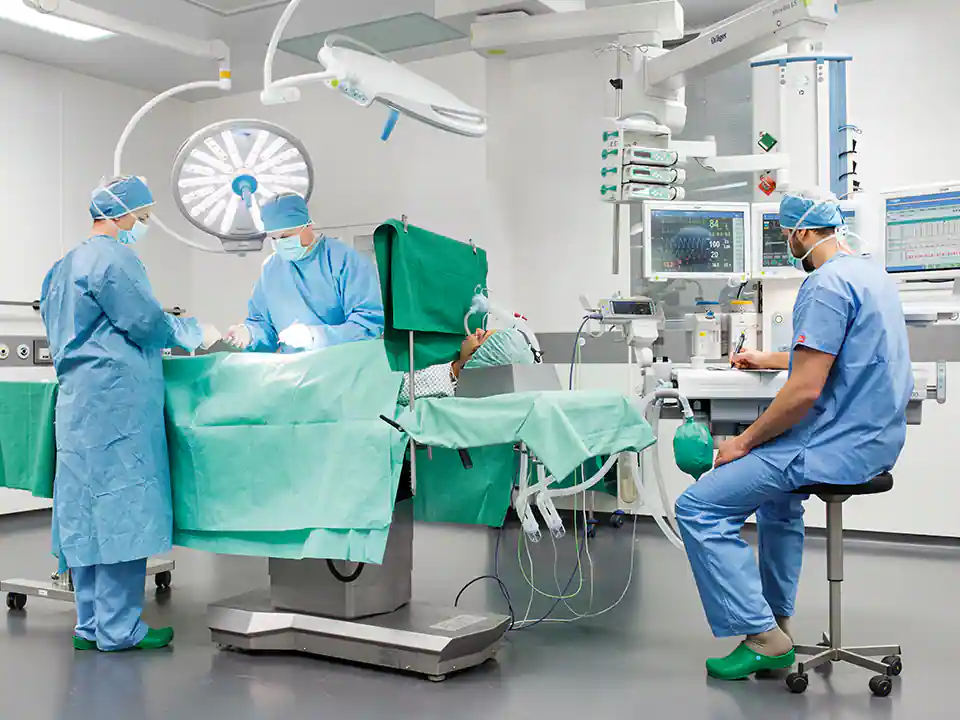The hospital’s own immunity is weak and it is also a gathering place for pathogenic bacteria. The ventilation and air conditioning system plays a key role in this. It can provide a good surgical environment for surgical patients and medical staff, provide clean air, maintain a reasonable pressure difference in rooms with different cleanliness levels, and control the air flow direction.
The difference from the purified air conditioning system is that it processes the air and proposes a higher cleanliness level. It controls non-biological particles and biological particles in the air, eliminates dust particles, controls indoor bacterial concentration, and makes the operating room reach the corresponding clean level. It relies on primary-efficiency, medium-efficiency, sub-efficiency, and high-efficiency filters to clean the air. Multi-stage filtration to remove dust, bacteria and other harmful gases in the air to provide clean air for operating room staff and surgeons. During the operation, it dilutes harmful gases, controls indoor airflow, and prevents the spread of bacteria in the operating room. Reduce the chance of infection during surgery.
Cold, heat, moisture load and cold and heat sources
The chilled water for the entire air handling unit and fan coil in the entire area is provided by the outdoor chiller. The temperature of the refrigerant outlet and return water should be stable to meet the rapid cooling requirements of the operating room.
Medical purification air treatment unit
For a clean surgical area, it can be simply divided into a direct current system and an air circulation system. Since the former supplies fresh air, the air handling equipment undertakes more arduous tasks than the latter. All air entering the clean area must go through a complete treatment process to purify the outdoor air parameters to the clean indoor air parameters. This directly leads to frequent replacement of filters and increases the overall operating cost.
Generally, air treatment adopts the combination of fresh air unit and air conditioning circulation unit. The fresh air unit bears the outdoor cooling and heating load. After the air is processed to certain parameters, it is mixed with some indoor return air in the circulation unit. After treatment, it passes through the static pressure box. Transported to the operating room. The application of the above method allows the fresh air to bear part of the indoor heat and moisture load, saving the return air duct of the air system.
The use of fresh air units and clean fan coils together provides convenience for independent temperature and humidity adjustment.
Air delivery and return methods
The operating room is supplied with vertical one-way air through the ceiling static pressure box. The clean airflow flowing through the high-efficiency filter flows from top to bottom, forming a local protected area in the surgical area. The surgical area with high cleanliness requirements is isolated from the surrounding environment by an airflow barrier, so that the protected area has an air cleanliness level that meets the requirements. Compared with the whole-room vertical one-way flow, the application of local one-way flow reduces the construction and operating costs of the clean air conditioning system.
The operating room adopts the air return method from both sides, and a medium-efficiency filter with a counting efficiency of no less than 80% for ≥1 μm atmospheric dust is installed at the return air outlet. The installation position is convenient for disassembly and replacement, and it also ensures that the air supply airflow is in the operating area. two-dimensional motion.
Control of pressure difference
Pressure difference control is achieved by adjusting the difference between supply air, return air and exhaust air. Compared with other low-level clean areas, the clean operating room maintains a minimum static pressure difference of 5Pa.
Operation management and maintenance
(1).Clean frequently to ensure efficiency
Air filtration is the basic means of air purification in hospitals. Filters are the core of clean engineering. The selection and application of filters directly affect the normal operation and maintenance costs of the system. For hospital air conditioning purification systems, the quality of the pre-filter directly affects the next step. filter life. In the early stage of operation, due to the failure to clean and replace the primary filter in time, the wind resistance increased, affecting the air volume, causing pressure alarms in the medium-efficiency filter and sub-high-efficiency filter, resulting in early replacement of the medium-efficiency and sub-high-efficiency filters. occur. Considering that the primary filter mainly filters large-diameter solid particles, by improving maintenance methods, attention should be paid to the cleaning and replacement of the primary filter (it is prescribed to clean once a week and replace once a month) to reduce the impact of medium-efficiency and sub-high-efficiency filters. The replacement frequency can effectively reduce operation and maintenance costs and make the equipment run efficiently.
The principle of air purification is to perform multi-stage filtration of outdoor air to finally meet the air requirements of the corresponding level. In order to better process the air, a medium-efficiency filter is installed in the fresh air unit. After use of the medium-efficiency filter, the filter screen is clogged and the pressure in front of the filter screen rises. When the pressure reaches 200Pa, the pressure difference alarm switch will prompt to replace it (replace it once a month).
The air flow after two-stage filtration is mixed with the return air through the air-conditioning circulation unit, passes through the sub-high efficiency filter, and is sent to the static pressure box. When reaching 300Pa, the pressure difference alarm switch prompts replacement. (Sub-high efficiency filter should be replaced every six months)
As the last barrier to purify the air, the high-efficiency filter needs to be replaced once a year or when the resistance reaches 380Pa after use.
(2). Control pressure difference and maintain balance
During operation, the balance between air inlet and exhaust is maintained according to the pressure difference and the opening degree of the return air of the control system. When the day’s surgery is over, the control system enters “night mode”: the blower will automatically switch to the minimum power required to maintain the operation of the operating room. During holidays, the fresh air unit and purification unit in the operating room will stop operating and will resume operation the day before the operation.
(3). Establish procedures and ensure operation
The purification air conditioning system should formulate corresponding operating procedures and be managed by dedicated personnel, establish equipment operation and maintenance regulations and files, and establish a self-inspection cycle suitable for the system.
Maintenance personnel on duty should record the operating parameters of the air conditioning unit, such as inlet and outlet water temperatures and pressures, air valve opening status, operating room supply and return air temperatures, etc.
At the same time, you should also check the operation of the purification air conditioning equipment, such as checking whether the filter, chiller and humidifier are alarming, whether the humidifier drainage is normal, whether the condensate water pipeline is blocked, and whether the air valves on the supply and return air pipes are safe. Reliable etc. Maintenance personnel should conduct self-inspections on the equipment under their jurisdiction, such as self-inspection, cleaning content and cycle.
(4). Monitor frequently to ensure function
The hospital’s clean room is a “controlled environment” that must be monitored regularly or continuously to assess the relevant technical parameters of the clean room. In daily maintenance, it is necessary to strengthen self-management and establish a good security system. During the operation of the clean room, the operation management personnel should regularly monitor the main technical performance indicators, monitor the number of air dust particles, temperature, humidity, etc. every month, and monitor the content of floating bacteria and sedimentation bacteria every six months. Monitor wind speed and volume once a year.
(5). Equipment use and emergency maintenance
For operating rooms, if the air conditioning system suddenly fails, it will directly threaten the patient’s life safety. Therefore, diversified energy, dual power supply, and backup energy must be configured. The air conditioning system unit must also have a backup mechanism to ensure safety and ensure normal operation under special circumstances.
Why Choose Us?

CNMEDITECH is dedicated to the long-term research of the medical equipment market. Our mission is “People oriented and win-win strategy,Matching the real needs of the region with a focus on human health,To be the world’s first-class medical field solution expert”.We have been manufacturing high-quality medical device products for more than ten years.
We have built our reputation on delivering quality healthcare solutions on time and on budget.All our products comply with international health and safety regulations and all products come with a warranty.
Are you still worrying about your customer’s product needs?Are you still angry that the product is expensive? We have various medical equipment and support personalized product customization.
Our company has many styles to choose from.In addition, we have high-quality pre-sales consulting guidance and professional after-sales service, all to meet your needs.
Whether it is a cost-effective or high-end product, there will always be something suitable for you.If you have any needs for products, you can ask us, our factory will meet your needs as soon as possible, and we will make every effort to provide you with solutions.Feel free to send us your inquiries.








